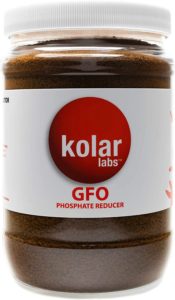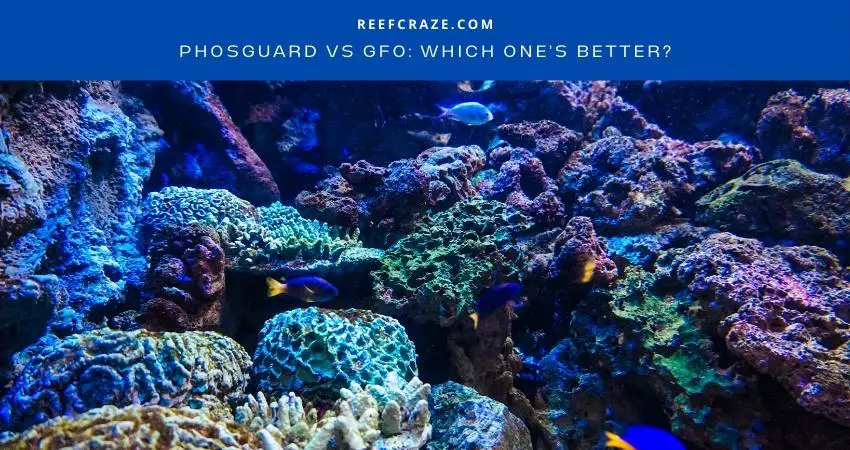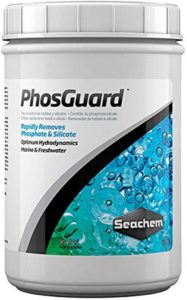Since it is mandatory to keep the phosphate levels optimum in your reef tank, you have to arrange appropriate tools for that. There are a handful of options in the market, such as PhosGuard and GFO. You would be right to have concerns about which one to use.
Both PhosGuard and GFO remove silicates and phosphates from the reef tank. But PhosGuard (aluminum oxide) does it a lot faster than GFO. Also, their uses vary within your tank capacity and condition.
There will be a broader discussion entailing their details. If you are a new reefer, you are in for some enlightenment for sure.
What Is PhosGuard? What Is GFO?
PhosGuard
PhosGuard, a porous component, acts as a chemical agent to remove inorganic phosphates in the water interface by precipitation. It is shaped like beads to facilitate unencumbered water flow around and through it to enhance its capacity and efficiency.
GFO

On the other hand, GFO, short for Granular Ferric Oxide, performs as a mechanism of chemical filtration installed in its reactor to control the algae population by removing phosphates from aquariums.
What Do They Do?
They both do the same thing – removing silicates and phosphates from the water to keep algae outbreaks at bay. However, GFO also absorbs components like arsenic, antimony, and fluoride.
You can use them both in marine and freshwater. But PhosGuard provides more effective results in seawater.
Additional Read: How to lower phosphate in a reef tank
How To Use PhosGuard In Reef Tank
You will get the best results if you use PhosGuard in a small quantity and change it frequently. It will exhaust within 4 to 5 days when applied in a tank with excessive amounts of phosphates.
Place the PhosGuard in an area with high flow rates, and test the phosphate levels. If they are under 0.2 ppm (milligram/liter), you need to use PhosGuard.
It may become yellow after picking up organics. Remember not to mistake it for a hint of exhaustion. Keep testing once a week until phosphate begins to scale up again. That is your cue to change your PhosGuard.
If there are not many phosphates, the PhosGuard will approach the silicates. It is safe and inert to put in the filter.
About the quantity – use ⅓ cup (85 ML) of PhosGuard for every 50 gallons of marine water and 100 gallons of fresh water.
How To Use GFO In Reef Tank
When installing your GFO reactor, separate the pump from the skimmer pump. You can position it in the return area of your sump.
Notwithstanding that, keep sufficient distance around the return section to make sure not to waste time by retreating the already processed water.
Here is more information about the measurement. Take 2 tablespoons of GFO per 8 gallons of water. If the plan turns out fine, double the quantity.
How Long Will They Take To Work?
PhosGuard
PhosGuard works so fast that it exhausts itself after working at its highest capacity within 4 days. That means you will have to replace the PhosGuard every 4 or 5 days until the phosphate level is optimum.
GFO
Varying on your tank shape, condition, and parameters, GFO will take at least 4 weeks to a maximum of 8 weeks to go into effect.
Can I Use PhosGuard And GFO At The Same Time?
Yes, you can, but that is not necessary. Using both GFO and PhosGuard will remove so many phosphates within a super-fast period that it will deteriorate the health of your corals.
If you decide to run both anyway, cut their quantities to half. Then increase them slowly before reaching the suggested amount for your reef system.

Which One Is Better – PhosGuard Or GFO?
From what I have observed, I will vouch for PhosGuard.
Although GFO works slower than PhosGuard, it is more aggressive. There is a chance that it can clear your tank of phosphates completely, causing shocks to your coral. Moreover, it removes essential elements like manganese and copper, the complete absence of which is not healthy for your reef friends.
You will not have that risk with PhosGuard. With massively high phosphate levels, it will perform efficiently within several days. It will also allow you to change its quantity until your tank has the desired level of phosphates. Hence, PhosGuard will not entirely remove the phosphates, posing no threats to your reef inhabitants.
So, PhosGuard beats GFO here.
Additional Read: Bio-Pellets Vs. GFO
Final Words
You have the final verdict from the PhosGuard vs GFO discussion. Both have a salient role in keeping your tank environment healthy and thriving.
But if you weigh their pros and cons, the better option seems to be PhosGuard. Nevertheless, I would still suggest you do more research on them and match your findings with your tank demands to land a decision.
Good luck!


